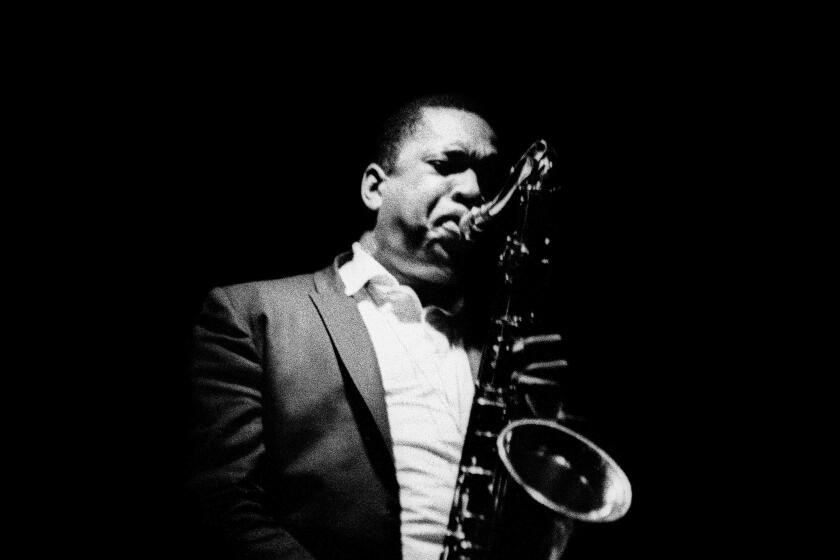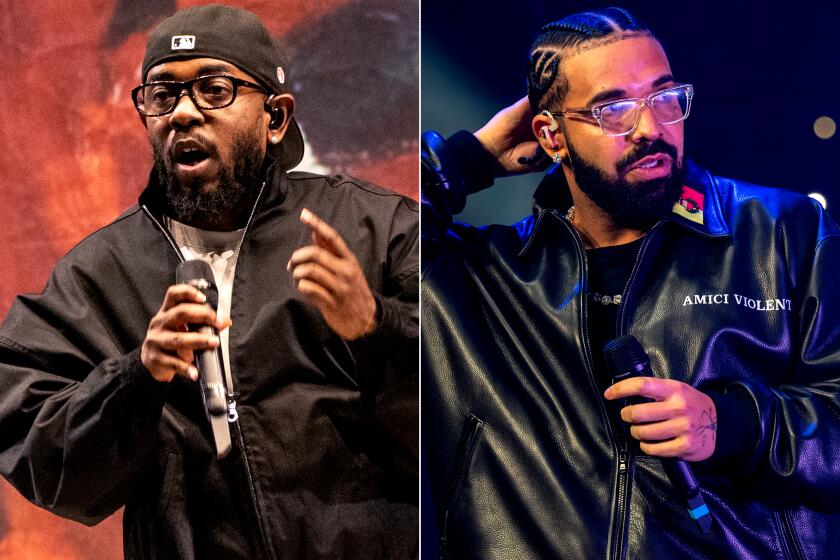Dance music festival Manana comes to Cuba and magic ensues: ‘Cubans have a right to demand concerts like this’
- Share via
Reporting from SANTIAGO DE CUBA, Cuba — “Solo quiero conectarme la Wi-Fi.”
That’s the hook from a new song by the Barcelona-based, Afro-Cuban singer and producer Kumar Sublevao-Beat. And throughout the hot, smoggy weekend of Manana Cuba, the country’s first international electronic music festival, it was everywhere.
The tune thumped out of a pre-party at the Casa Micaela, a windowless nightclub behind a secret door in a restaurant off the central Parque Cespedes. It rang from the main stage of the Teatro Heredia, a swooping modernist cultural complex where Kumar fleshed it out with local jazz musicians and traditional drummers.
The song’s plea for a Wi-Fi password was cheeky but defiant. The Santiago locals and English club-music nerds sweating down the walls together could tell what it was really about: a Cuba hungry for connection, at the precipice of big changes.
After President Obama’s recent visit, relaxed travel restrictions for Americans, Havana concerts from the Rolling Stones and Major Lazer and a traffic-stopping fashion show from Chanel, Cuba’s relationship with American culture and the global economy is undergoing a profound reset.
How that’s going to happen -- and to whose benefit -- is still uncertain.
Music festivals always promise a kind of cross-cultural empathy. But at the risk of romanticizing a country of profound poverty and generations of human rights challenges, Manana really found it.
This event’s brought awareness that Cubans have a right to demand concerts like this. That it’s a great exchange [between cultures] and not a competition.
— Edna FĂĄtima JoÄo Juisse, a medical student from Mozambique studying for her M.D. in Havana
“People have known for centuries that Cuban musicians are amazing,” said Edna Fátima Joāo Juisse, a medical student from Mozambique studying for her M.D. in Havana. She saw Major Lazer and the Rolling Stones’ recent shows there but came for Manana because she felt it was something new.
“This event’s brought awareness that Cubans have a right to demand concerts like this,” she said. “That it’s a great exchange [between cultures] and not a competition.”
Manana, held May 4-6, imagined a different future for the coming connections between Cuba and the outside world. The fest’s three co-founders – Santiago native Alain Garcia Artola and Londoners Harry Follett and Jenner del Vecchio – conceived the event while recording Artola’s hip-hop project TnT Rezistencia and other acts in the Santiago slums.
They imagined Manana as an intermingling of global producers and Cuban artists sharing ideas on their own terms in a city far from Havana’s famous Malecón boardwalk.
Santiago is the center of Afro-Cuban culture – it’s closer to Haiti than Havana, and it’s where Castro fired the first shots in his own Cuban revolution. It’s an isolated city built on insurrection, with Caribbean-style carnival festivities that are unique in Cuba.
Music there has been a source of fundamental expression (and a target for political repression) since colonization. Even today, the city feels like a tropical ‘70s Berlin – cultural brilliance woven into industrial decay.
“This is happening where you wouldn’t expect it. Because it’s happening in Santiago, it’s a whole other feeling,” Artola said. With his long twists of dreadlocks and ethereally calm demeanor, he was the face and the soul of the festival (and possibly the hippest guy in the world’s most exciting country for music).
“This is the city of culture in Cuba,” he said. “There’s a new generation with a different way of seeing music, and there’s a responsibility to protect this richness. I’m like a really jealous lion. I want to protect this feeling.”
The three founders cobbled funds from a variety of sources – a successful Kickstarter campaign, some support from the Cuban government – and teamed with the British firm No-Nation to help produce it. The challenges of throwing a festival in a communist country, in a city with barely any internet access, let alone high-end live-sound equipment, were substantial. One English production manager dryly noted that, after requesting some wood for an installation, it arrived in the form of a freshly disassembled boat.
The difficulties were “the hardest I have ever worked with in major event management,” said Alice Whittington, the fest’s head of logistics and its international artist liaison. More unexpectedly, “the machismo was surprisingly very strong and I found it difficult to be taken seriously. The few times I did get things done alone, it would be usually followed by a wink or a flirtatious brush of a hand from the male party, or even a ‘mi amor,’ which I had to grin and bear.”
But still, she said, the experience “gave me faith in the human race that it’s possible to achieve something so special.”
You could feel it as the crowds of Santiagueros (who each paid the equivalent of $2 to attend the fest) got down to the East L.A. house-party vibes of the tiger-masked Calentura D.J. crew. You could feel it in the rectory of the Sala de Conciertos Dolores, a church-turned-concert-venue where the U.K. experimental electronic duo Plaid cut tracks with percussionists from the Cuban group Danza del Caribe, who later joined them for a live set.
“At our first session,” said Plaid’s Ed Handley, “we just listened to them play. We didn’t know what to expect. But that spirit, they’ve got it in spades here.”
Onstage, the band added hazy computer pulses to the drummers’ rigorous 6/4 rhythms and drew a few tears from sunburned techno fans in the front rows. (Many, admittedly, had been swigging $3 bottles of Havana Club rum for about 12 hours that day. But, hey, even Santiago’s trova music legend Sindo Garay once got drunk on a boat and ended up in Havana by accident in 1903.)
Afro-Cuban music has distinct structural elements that made an uncanny partner for modern club music. As scholar Ned Sublette wrote in “Cuba and Its Music”: “Cuban music has something else: a clave (a rhythmic key) and those undulating, repeating, melodic-rhythmic loops of fixed pitches.”
Western fans expecting to rave were more often captivated by Manana’s more traditional acts – the rumba groups Obbatuké, La Botija and Rumba Ache spanned musical eras and brought rooms to their feet. The 76-year-old drummaker and percussion legend Mililián Galis hypnotized an afternoon crowd in the teatro – even if you didn’t know his legacy, you could feel a bone-deep link to Cuba’s past when he played.
But there are risks in this crossover. How might Manana open Cuba to the world while also preserving a culture where music is a profound, fundamental expression of identity?
“When people come with good intentions and to collaborate in a balanced way, it’s a good thing. But they can’t come with a colonial mentality. The act of listening is so important,” said DJ Jigüe, a Santiago-based producer, label owner and a nexus for the fest’s acts (he threw the party with Kumar where foreign fans first heard his “Wi-Fi” single).
Through a translator, Jigüe added: “There’s so much new technology and information, and my ‘80s generation has experienced every change. But we also have to understand what’s important and what’s not.”
One of the fest’s most popular acts – the Havana-based duo Pauza, whose mix of hard house music and sampled Santeria chants could easily hit Coachella’s Yuma Tent – didn’t fear that global interest would dilute Cuban culture.
“Cuba is the bellybutton of the world,“ said the group’s 23-year-old Paula Fernández, implying that Cuba has been at the center of life in the Americas for more than 500 years. “This idea to mix Cuban folkloric music with electronic music at a festival, it’s never happened before. Cuban music is pure. But it also has to change.”
That much is inevitable. The Manana festival (named for the wife of a Cuban revolutionary general in the war for independence) intentionally echoes the Spanish word for “tomorrow.” For younger Cuban acts like Pauza and the electronic producer Wichy de Vedado, it was obvious that they can’t wait for the future to get here.
But as foreign fans burned off their hangovers by piling into ‘50s Bel Airs to visit the beach by the San Pedro de la Roca Castle, they’d pass the machete-circled Antonio Maceo monument and the bullet-scarred Moncada barracks (the site of Castro’s first raid) en route back to the festival. Some fans whispered about rampant sex tourism and plainclothes secret police walking the dance floor, hunting for drug use or political talk. At Manana, there was so much past to be reckoned with as well.
For Artola and his crew, the fest was a genuine, tentative first step toward re-imagining Cuba in a new world, and defining what that exchange can and should be about.
“It’s been a huge challenge,” he said, finally calm after a morning spent rerigging stages when the outdoor patio got waterlogged. “But all of my friends are here. Even after all the rain and the stress, I’m still having so much fun. I want to do this for the rest of my life.”
Even when it seemed to fall apart, Manana could still conjure magic. When the Chilean American headliner Nicolas Jaar took the stage around 2 a.m. on Saturday, the rains came hard. Soft at first but eventually blinding. Organizers had to cut his set short – the stage’s tent overhangs were threatening to burst and short out the whole system.
But for about 45 minutes, everyone just danced. The hot Caribbean rain poured off fans’ faces in the haze of orange street lamps. Whatever was intractable or hopeful about Cuba, whatever was fraught in this cultural transaction, whatever might be lost in translation as Cuba opens up – right then, on the dance floor in the torrents of rain, everything seemed connected.
ALSO:
Insomniac announces EDC Las Vegas lineup
Unlocking Cuba: Travel tips, guides, photos and more
Madison Square Garden is bringing a new concert arena to Las Vegas
In Havana, following a USC museum director in search of great Cuban art
More to Read
The biggest entertainment stories
Get our big stories about Hollywood, film, television, music, arts, culture and more right in your inbox as soon as they publish.
You may occasionally receive promotional content from the Los Angeles Times.











